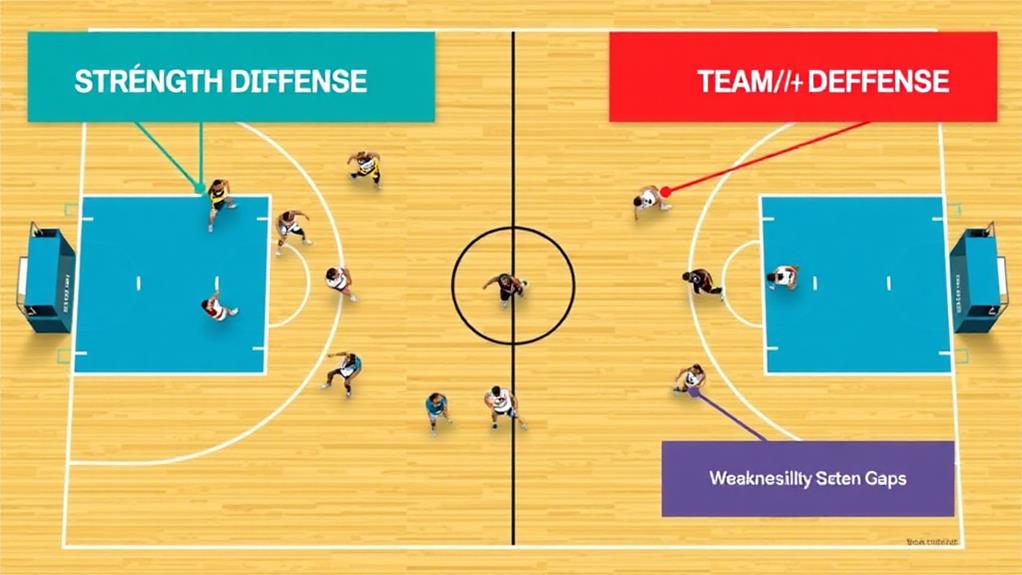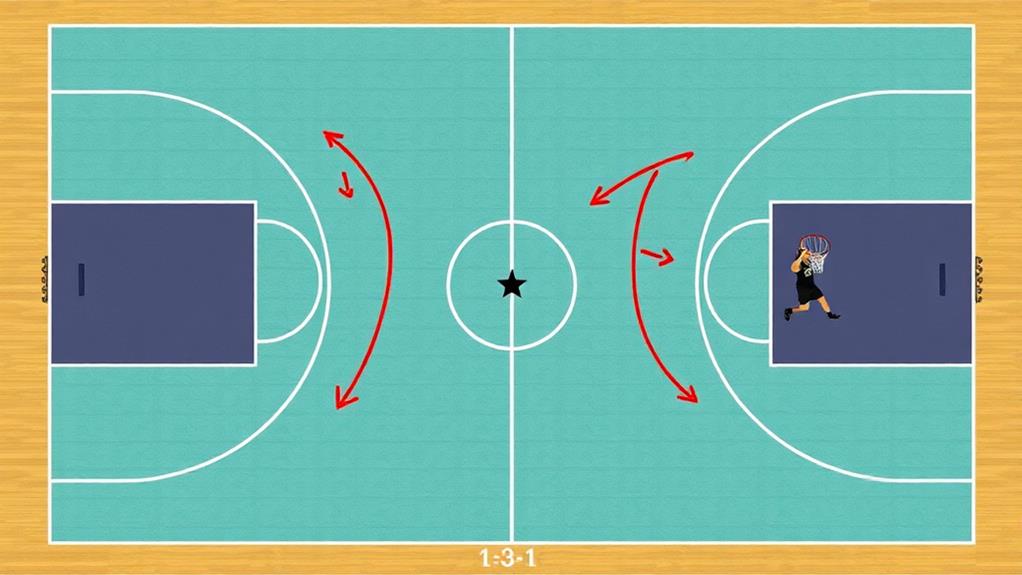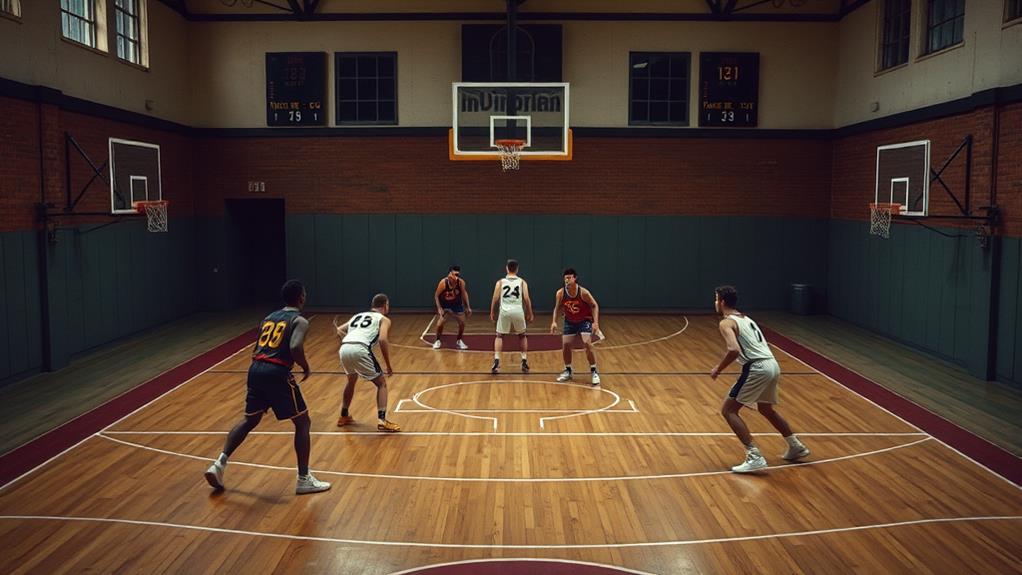
The 1-3-1 Zone Defense: Strengths and Weaknesses
September 29, 2024The 1-3-1 zone defense disrupts offensive play by applying pressure and creating confusion, which often leads to turnovers. With three players positioned in the middle, it excels at rebounding and challenges perimeter-heavy teams effectively. However, this formation is vulnerable to sharp shooters in the corners and struggles against dribble penetration, which can leave gaps in coverage. Communication and teamwork are essential for its success, so overcommitting to one area can be risky. Understanding both its strengths and weaknesses provides a solid foundation for implementing this strategy effectively, and you might find even more insights as you explore further.
Overview of 1-3-1 Zone Defense
In the domain of basketball strategy, the 1-3-1 zone defense stands out as a dynamic formation aimed at disrupting offensive flow. This zone defense features one player at the top, three in the middle, and one at the back, which strategically covers key areas of the court. By applying pressure on the outside arc and high post, it limits the offensive options available to the opposing team.
The evolution of defensive strategies highlights the importance of adapting formations like the 1-3-1 to counteract modern offensive tactics and prioritize perimeter defense to challenge high-efficiency shooters, particularly as seen in recent trends in the game. Historical shifts in defensive approaches reflect ongoing refinements necessary to keep pace with evolving gameplay.
One of the strengths of the 1-3-1 defense is its ability to trap ball handlers, creating opportunities for turnovers. However, effective communication among defenders is essential to maintain formation integrity. Each player must clearly understand their assignments to respond effectively to offensive movements.
Despite its advantages, the 1-3-1 zone can be vulnerable to attacks from the corners and low post. This necessitates that defenders remain agile and alert, ready to prevent scoring opportunities.
Successful execution relies heavily on anticipation skills, allowing players to quickly rotate and cover gaps created by ball movement. Understanding these dynamics will help you appreciate the complexity and potential pitfalls of the 1-3-1 zone defense.
Advantages of 1-3-1 Zone Defense
The advantages of the 1-3-1 zone defense make it a compelling choice for teams looking to enhance their defensive strategy. This formation promotes a strong rebounding presence with three players in the middle, which can be particularly effective in controlling the paint area.
Additionally, it increases the likelihood of contested shots, especially against perimeter-heavy teams, as defenders can quickly close out on shooters. The zone creates confusion for offenses, leading to turnovers and offensive disarray, while also providing opportunities for fast breaks after defensive stops.
Teams can also find adaptability to the strengths and weaknesses of the opposing team, much like how the offside rule enhances strategy in soccer.
Disadvantages of 1-3-1 Zone Defense

While the 1-3-1 zone defense has its strengths, it also comes with notable disadvantages that can hinder a team's effectiveness. One major weakness is its vulnerability to sharp shooters positioned in the corners. These players can exploit gaps, often leading to open three-point shots.
Additionally, this zone defense requires exceptional communication and teamwork among players; without it, breakdowns in coverage can occur, allowing opponents to find easy scoring opportunities. Proper spacing and coordination are essential for maintaining defensive integrity, as emphasized in collective decisions during team drills.
Another issue arises when teams effectively trap the ball. Overcommitting to one area can create gaps that offensive players can exploit for easy baskets. If opponents isolate a defender against a stronger post player, maintaining integrity becomes challenging.
The 1-3-1 typically has fewer low defenders, making it difficult to contest shots in the paint, especially against teams with a powerful inside presence.
Moreover, the zone may struggle to stop dribble penetration, as wing defenders can be pulled away from their responsibilities.
Key Strategies for Implementation
To make the most of the 1-3-1 zone defense despite its vulnerabilities, implementing key strategies is vital. Here are some effective tactics you can use:
- Emphasize clear communication among defenders to maintain positions, as effective communication fosters defensive solidarity.
- Regularly practice defensive rotations to anticipate ball moves.
- Focus on positioning to cover shooting zones, especially corners.
- Implement teamwork drills to improve defensive synergy.
- Use video analysis to adapt strategies against opponents.
In high school basketball, teaching your players to recognize gaps is essential. As the ball moves, make certain that your defenders X out on any offensive players in the post.
When the wing X2 drops to help, it creates a trapping defense that can pressure the ball handler. Encourage your players to communicate continuously, so they know when to adjust based on the offense's tactics.
Furthermore, regular practice of defensive rotations will sharpen their instincts, allowing them to cover gaps effectively.
With consistent drills and strategies, your team can strengthen its zone defenses and minimize the vulnerabilities of the 1-3-1 formation. By focusing on these key strategies, you'll empower your players to excel in this defensive approach.
Historical Context and Usage

Originating as a strategic option in basketball, the 1-3-1 zone defense gained traction in the late 20th century, appealing to teams aiming to bolster their defensive strategies. This formation became especially popular among high school teams and college teams due to its adaptability to various player skill levels.
Notable NCAA coaches, like John Beilein and Seth Greenberg, have successfully integrated the 1-3-1 zone into their playbooks, showcasing its effectiveness at higher levels of competition. Additionally, the evolution of women's basketball, influenced by trailblazing icons like Cheryl Miller, has further emphasized the importance of versatile defensive schemes like the 1-3-1 zone.
The 1-3-1 zone's design allows for a dynamic defensive setup, enabling teams to effectively guard against both perimeter shots and drives to the basket. Over the years, the defense has evolved, leading to numerous adaptations that allow teams to tailor it to their specific strengths and weaknesses. This flexibility is a key factor in its sustained relevance.
Successful utilization of the 1-3-1 zone has even been observed in championship games, highlighting its effectiveness in modern basketball tactics. By understanding its historical context and usage, you can appreciate how the 1-3-1 zone remains a valuable tool for teams aiming to enhance their defensive capabilities.
Conclusion
In the world of basketball, the 1-3-1 zone defense can be a double-edged sword. While its strengths can frustrate opponents and create turnovers, its weaknesses can leave you vulnerable if not executed properly. By understanding its advantages and disadvantages, you can harness this strategy effectively. So, as you step onto the court, remember: mastering the 1-3-1 is like dancing with a partner—timing and coordination are everything for a graceful performance.


